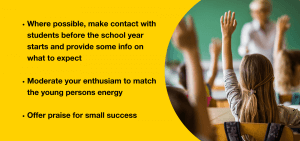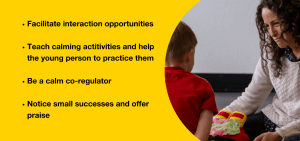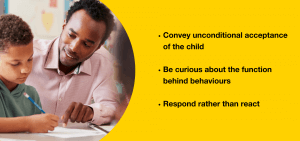
Back to school for traumatised children – from chaos to calm
‘Back to school for traumatised children – from chaos to calm’ blog article was written by Donna Smyth, Senior Training Consultant at Australian Childhood Foundation.
The beginning of a new year is alive with optimism – we are refreshed and hopeful, full of plans, goals and hope.
But for many children, the New Year does not carry these things. For many, Christmas and Easter have not been a happy time of celebration, joy and relaxation, but full of turmoil, uncertainty, conflict, hunger, tension or disappointment. For some, there is nothing new about a new year or a new term – there is little sense of hope for change.
For other children, the break has been nothing but change – family conflict often escalating over the festive season, and spikes in family violence, substance use and financial strain being all too common.
There will be children whose parents have separated over the holidays. There will be children who have suffered abuse and witnessed violence during the break. There will be children who have been removed from their parents and placed into care – a different bed, a different car, a different teddy, and now a different school uniform. For traumatised children and young people, a return to school is not marked with excitement and joy. Instead, it can represent more change, bring more uncertainty, and invoke more fear. How can schools provide an environment of safety for these – their most vulnerable students?
We believe that schools are uniquely placed to offer a sense of calm, safety and hope for those returning to school out of chaos.
While the task is big, we believe there are some key principles that can help with the use of a few strategies before the day, on the day and after the day.
1. Warm and welcoming
How students are welcomed into a new school, a new class, or even just a new term – can make a huge difference in how they perceive and engage in school, relationships and learning. We can begin welcoming students before they even set foot in the classroom on the first day back. I know my own children look forward to their pre-term letters from their teachers – addressed to them in the post before the start of term – welcoming them to their new class, sharing some “who am I” info, and describing the theme for the term (this often including instructions for dressing up on the first day). Not only does this build excitement, but let’s face it – none of us do well with the unknown, and we are all put at least a little at ease when we have some clues as to what to expect. This is an extra bonus for most students but an absolute necessity for our traumatized children. A little bit of information can help to transform apprehension into excitement.
Welcoming children to school can take many forms.
It’s natural for us to expect excitement and enthusiasm from students at the beginning of a new year –based on the assumption that school is a positive place and that they are going to enjoy being there. However, our huge smiles and bright, happy “welcome back!” statements must seem confusing at best and threatening at worst to those children for whom school has been a place of turmoil, fear and rejection. Sometimes, a gentle smile and look of understanding can convey to a child that you are happy to see them, but you understand they might not be so excited to be there. This can be applied to parents and carers as well, who might be tempted to try and “convince” the child that they should be feeling excited (“Come on! Don’t be silly! You’re going to have a GREAT time!”), rather than conveying empathy for how the child is actually feeling (“I know it can feel scary starting at a new school; I’d feel a bit that way too, but we’re going to make it as easy and fun as we can!”). It’s important that we moderate our enthusiasm to meet the child/young person where they are at – not to greet fear with fear, but to acknowledge the fear through our gentle, calm greeting.
The first day back can be a great time to share stories of holiday adventures, but use sensitivity and considered judgement in how “getting to know you” activities are facilitated – as these situations can often be overwhelming for traumatised children, who would rather not share what happened – or of course invite the inevitable “over-share” that can silence the room!
At the end of the day, a personal farewell can make a great difference in wrapping up the day on a good note. A quiet “you did so well today – I’m glad I’ve got you in my class” or a quick word of assurance to a parent/caregiver at pick-up can be really affirming.
When the hustle and bustle of the first day is over, continue to check in with the child/young person, as it will likely take more than one good day for them to feel settled and welcome, and continue to offer praise for small moments of progress.

2. Predictability: Transitions and change
Many traumatised children and young people can struggle with change and transitions. Not just what we might call major changes either – even small changes can trigger a threat-fear-survival response.
These might include desk changes, a new timetable, sport being cancelled for the day or a surprise new classroom set-up. Transitions pose similar issues – we often see children’s behaviour escalate or deteriorate when coming back in from recess/lunch or for high school students changing classes between subjects. When it comes to the first day back at school, change is everywhere, and this can overwhelm a traumatised child’s system.
Having some ideas before the first day back on how you can foster predictability and manage planned and unforeseen change will take the pressure off trying to brainstorm on the hop during the term.
On the first day, as early as possible, outline what to expect for the day, the week, and the term. Although many students only need to hear this once to remember it, be sure to repeat plans regularly – using visual cues (such as graphic timetables for younger students and enlarged printed timetables displayed for older students). The first day is as good a time as any to introduce a routine for transition times. You may have a favourite that you like to use or may wish to involve the class in developing a new one together. Transition routines can include a song that is played, a call and response that the teacher and students come up with together, a brief desk-top drumming routine, or a short mindful breathing activity. Explain that this routine will be used at the start and end of the day, after recess and lunch, and when swapping activities during the day. This creates as sense of familiarity around transition times, which are otherwise characterised by uncertainty.
After the first day, continue to notice how the young person responds to change/transition and offer praise and encouragement for small steps.
When disruptions are planned/known – be sure to prepare the student for this in advance. This includes even positive events like excursions – which can often see a vulnerable child’s behaviour unravel. Unexpected changes are always going to crop up, but we can be proactive in managing these in sensitive and responsive ways – (for example, if a teacher is away sick and a relief teacher has been arranged, having a familiar staff member greet the student before class to notify them).

3. Calm and Connected
Traumatised children and young people are often in a heightened state of arousal, their brains and bodies scanning for danger and threat and primed to react with fear-based responses. These students have limited tools to use to calm themselves down or remain in a calm state, and they need our help to achieve this.
Giving thought to the sensory environment of the classroom is important, as some children are easily overwhelmed by too much visual stimulation. A child in a threat-detecting state is not in a learning state; therefore, instilling calm and safety is the quickest route to promoting the learning capacity of a traumatised child. Have a handful of calming activities up your sleeve to trial throughout the day, and as the term progresses, work with the child and their key adults to develop their own preferred calming strategies, then encourage and support them in practising these regularly. Most importantly, remaining calm and being a co-regulator is the best way to support a child in becoming calm and learning to regulate themselves.
When our minds and bodies are in this heightened state, not only are we unable to learn, but we are unable to be socially engaged.
Traumatised children and young people often find navigating peer relationships complicated and overwhelming. Where many children may quickly connect with others on the first day back, traumatised children will need some help. Providing some facilitated opportunities for interaction and some structure around playtimes will support the young person in making connections with their peers and feeling calmer during “social” times. Be sure to make social expectations explicit (to the whole group – without singling anyone out) and repeat these often.
And – as always – notice and praise even the smallest of successes and progress.

4. Open and Engaged
We know that having even one positive, secure attachment relationship with a caring adult can dramatically influence the outcomes for a young person in all areas of their life.
We also know that, for many children with histories of trauma, a safe relationship with a trusted teacher can be their primary protective factor and the most likely predictor of positive outcomes in school.
“Human interactions in the context of safety create the best environment for learning” (Bomber & Hughes, 2013). When a traumatised child experiences anger from a teacher, their defence system is activated – in which case they are not able to reflect on their behaviour or learn from the consequences. This level of learning only occurs when a child perceives safety.
When a teacher’s relationship with a child conveys unconditional acceptance, the child can remain in a socially engaged state – which allows for reflection and learning to occur.
Having an open and engaged approach involves singing a modulated, rhythmic voice, being accepting of the child themselves and being curious about the behaviours that challenge us. This allows us to respond (to the underlying need) rather than react (to the behaviour alone).
Where most students hold an unassuming trust and positive regard toward teachers, a traumatised child is primed to mistrust adults and will take time to build a relationship – but, more than any new literacy program, assessment tool, app or smartboard, the greatest resource at a teacher’s disposal will always be the teacher themselves. The relationship is your greatest tool!
Building relationships, trust and calming/engaging strategies with traumatised children and young people takes time. Progress may be slow, but don’t lose heart!
You are working to create a new experience and a new template for this young person, and your investment will be well worth it. Extra planning for a smooth first day back can go a long way to laying the foundation for a great year ahead.

Subscribe to the Professionals Newsletter
Join our community of more than 40,000 professionals from around the world who receive our weekly newsletter containing articles. Our newsletters help connect you to our blog, research, and free resources as they are produced. We also keep you informed on training opportunities including access to experts in the field, webinars, international speaker tours, conferences and more.
